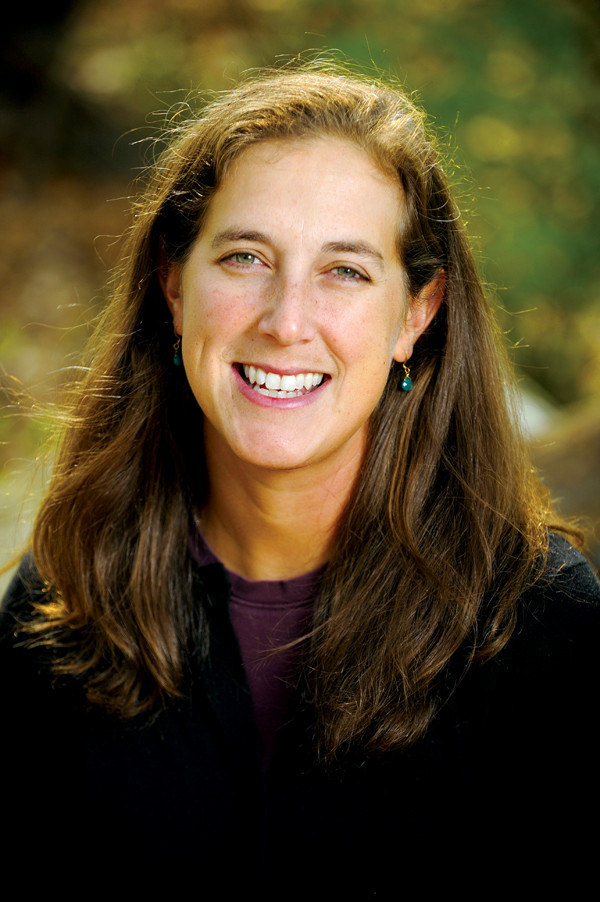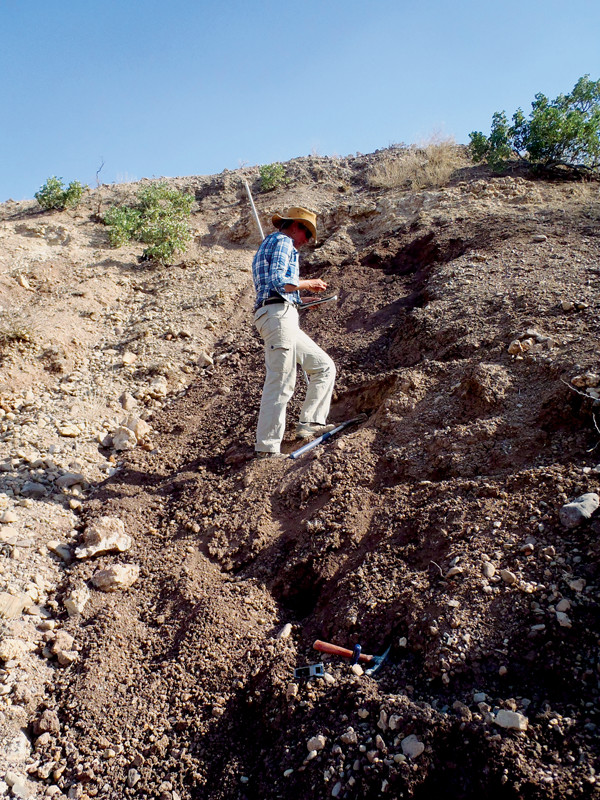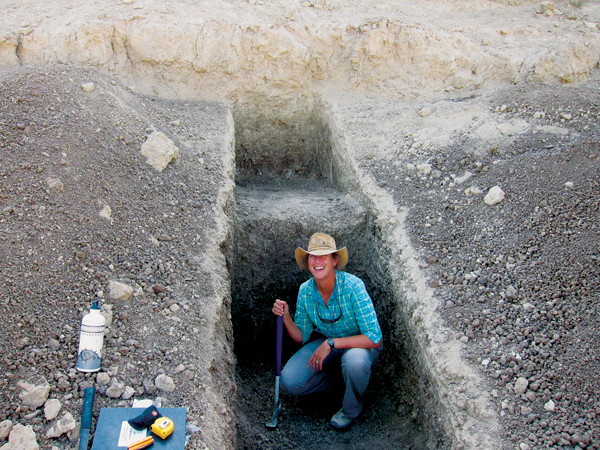
by Timothy Oleson Tuesday, December 9, 2014

Naomi Levin is a stable isotope geochemist. Credit: Will Kirk/Homewood Photography, Johns Hopkins University.
Stable isotope geochemist Naomi Levin, a native New Yorker, says she could easily imagine alternate career paths that would have been more in line with her urban roots. But the hands-on nature of both fieldwork and lab work lured her to geology and anthropology. And after working with a string of prominent geochemists — including Jay Quade, Thure Cerling and John Eiler — as a graduate student and post-doctoral researcher, Levin has quickly moved to the top of her field.
Since becoming an assistant professor at Johns Hopkins University in Baltimore in 2009, she has received two prestigious awards from the Geological Society of America (GSA). In 2011, she received the Subaru Outstanding Woman in Science Award. And last October, at GSA’s 125th anniversary annual meeting in Denver, she became the 25th winner of the Young Scientist Award.
Although Levin has branched out into other topics as she has built her own research group, many of the projects she has been involved with have taken her to East Africa. Working with diverse scientific teams, she has helped illuminate the climatic and ecologic conditions in which human ancestors lived millions of years ago by analyzing the isotopic compositions of soils and fossils from Kenya’s Turkana Basin, the Afar region of Ethiopia and other areas.
EARTH staff writer Timothy Oleson spoke to Levin last fall about some career highlights, and about how growing up in New York City was good preparation for working in the field.

Levin stands among Pliocene deposits at Gona in the Afar Rift of Ethiopia, one of two sites where fossils of the roughly 4.4-million-year-old hominid Ardipithecus ramidus have been found. Credit: Daniel Peppe.
TO: You’ve now received two awards from GSA. What does the recognition mean to you, and how do you value each award?
NL: I feel very honored, but a bit sheepish too. Sometimes, you just want to keep your head down and do your own work. But it’s a privilege to be recognized by a society that facilitates so much research and that represents a long tradition in geology.
The Outstanding Woman in Science Award was really cool because I was able to speak to a group of young female geoscientists when I was at [the annual meeting of] GSA in 2011, and it was neat to talk to them specifically in that light. Sitting on the awards stage in 2011, I wouldn’t have fathomed that I would be back [in 2013] and being recognized at another level. The people who’ve received the Young Scientist Award are very distinguished, so it’s an honor. I feel like I need to continue to work hard to do that award justice, so it’s a good motivator to stay on track and continue to work on exciting problems.
TO: In his citation for you when you received the Outstanding Woman in Science Award, Jay Quade said you’d attributed your ability to overcome challenges during fieldwork partly to your experience growing up in New York City. How did this help?
NL: There are a lot of the same skills involved [in navigating a big city and in fieldwork]. Growing up, I had to take the subway to school. You learn some good life lessons with that kind of independence. If you’re a seventh grader and you get off at the wrong subway stop, you have to look like you know what you’re doing … as if you own the place. It’s similar with fieldwork: You have to be aware of your surroundings and you have to know where you’re going. It’s partly about having your bearings, and then being confident enough just to explore … to say “OK, here’s my mission for the day,” and then have the wherewithal to get it done.
TO: There is a lot of debate about the climate and conditions in Africa during the emergence of human ancestors. What aspects have you tried to tackle in your work?
NL: Recently I’ve been involved in studying the role of C4 plants [which first became abundant in the Late Miocene and used a photosynthetic pathway that was better adapted to low-water and low-carbon-dioxide conditions than earlier-evolved and more abundant C3 plants] in human evolution in East Africa starting in the Pliocene about 5 million years ago.
In Ethiopia, my colleagues and I showed that, at a site where this [roughly 4.4-million-year-old] fossil hominid called Ardipithecus ramidus — nicknamed Ardi — was located, C4 grasses were substantial parts of the landscape. But where they were living and what they were eating are two different issues. Isotopic data have clearly shown that Ardi was eating C3 vegetation, likely some products of trees or shrubs. It’s not until about 3.4 million years ago that human ancestors like Australopithecus afarensis started to use C4 plants. They start to show up in the diet of these animals, and that corresponds to times when there seem to be more adaptations to bipedal living.
We’ve also shown that scientists need to look at more than one site to understand the relationship between a fossil organism and its environment. Fossils of Ar. ramidus have been found in the Aramis area [of Ethiopia] and then also in an area just north of Aramis called Gona. When you look at these two sites, they’re different environments. That’s cool! That’s saying, “OK, we know that this early human ancestor was not limited to one sort of environment,” which is an important piece of information.
TO: Is there a common theme among your various projects?
NL: I’m part of a team that builds context — describing where fossils were found and how old they are. But I’m also interested in fitting that context of the fossils into a bigger ecological context. How do these organisms fit into an environment, and also, how does this environment fit into a regional or global climate story or landscape story? Can we patch together all of these different records to build some sort of synthetic view of how terrestrial environments respond to climate change? Can we come up with good geologic tools to reconstruct terrestrial environments, which, by their nature, are messy and complicated? It’s a big task, but it’s an important task to understand how terrestrial environments respond to global climate changes. That’s the big picture.

Among the research that has taken Levin to East Africa is a Smithsonian-led project characterizing the environmental and climatic conditions during the last million years at Olorgesailie in southern Kenya, a site with a rich archaeological and paleontological record. Here, she samples carbonate nodules from a trench excavated in an Olorgesailie paleosol. Credit: Kathryn Ranhorn.
TO: What is your favorite part of the research process?
NL: I think it’s the package deal. The first component is being in the field, which I liken to a life-size chess game because you physically move from place to place, but you also have to be strategic about how you move. It’s this great combination of physical work and collaborations. When you’re living with people in the middle of nowhere in a tent camp for weeks on end, awesome scientific exchanges arise because you’re sitting around the fire, eating together every night, and you’re talking about what you saw in the field and asking questions that you probably wouldn’t have time to ask normally.
After I’ve been in the field for three months, I’m usually itching to analyze my data and get the numbers. It’s almost like opening presents. You’ve collected all these samples, and by doing the careful analytical work, you can start to see answers coming through.
The third part is the writing process, which takes me back to my collaborators because, for example, I need to know information about the animals that we’re getting isotopic data on in order to understand what the data fully mean. There is just as much learning that happens in hashing out the data and figuring out the story and what it means.
TO: You were a graduate student not too long ago. Is it different having your own students to advise and work with now?
NL: It’s been a huge eye opener, and I think it’s given me a lot of appreciation for my own advisors. A lot of being a graduate student and a post-doc is figuring out how you work and how you can be successful. The challenge of being an advisor is how to get other people excited and how to promote their work, while recognizing that they’re going to work differently from you. But it’s quite satisfying to facilitate others’ research.
I work on so many more projects now than I did five years ago. Suddenly, I have this broader reach. Sometimes it’s a juggling act to stay on top of it all, but it’s exciting to have my hands in a lot of different kinds of science. This is enabled because of the students and post-docs with whom I work.
© 2008-2021. All rights reserved. Any copying, redistribution or retransmission of any of the contents of this service without the expressed written permission of the American Geosciences Institute is expressly prohibited. Click here for all copyright requests.